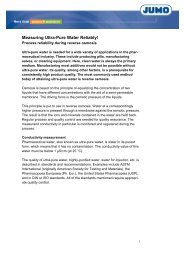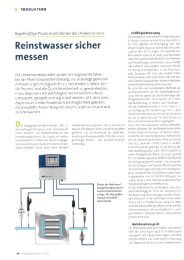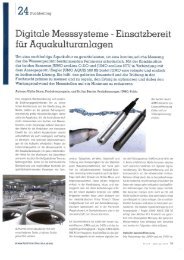sensors + automation
Create successful ePaper yourself
Turn your PDF publications into a flip-book with our unique Google optimized e-Paper software.
➋<br />
JUMO tecLine pH combination electrode<br />
Type 201020<br />
Redox potential measurement<br />
A measurand for monitoring chemical processes<br />
➍<br />
➊<br />
➋<br />
➌<br />
➍<br />
➎<br />
Rounded gold or platinum end<br />
Internal conduction system<br />
Reference electrolyte<br />
Conduction system<br />
Diaphragm<br />
➌<br />
➎<br />
➊<br />
Redox potential is a commonly occurring<br />
measurand for monitoring chemical<br />
processes in industrial and municipal<br />
wastewater plants as well as in bathing<br />
water monitoring facilities.<br />
Redox potential – reduction and oxidation<br />
The redox potential is a measure for the<br />
reduction or oxidation potential of chemical<br />
reactants such as in liquid media. It<br />
describes the degree to which substances<br />
are able to absorb or release electrons.<br />
The redox potential is measured<br />
in mV or V.<br />
A substance that releases electrons is<br />
oxidized and the electron-absorbing substance<br />
is reduced.<br />
The substance that oxidizes the other substance<br />
is referred to as an oxidant. It has<br />
the higher redox potential. At the same<br />
time, it absorbs electrons and is reduced.<br />
Examples for oxidants include oxygen,<br />
disinfectants such as chlorine or ozone,<br />
peroxide, sulfur, or bleach.<br />
Reducing agents refer to a substance that<br />
reduces the other substance. It simultaneously<br />
releases electron itself and is<br />
oxidized. Its redox potential is lower. Examples<br />
for reducing agents include organic<br />
substances – such as sugars, fats,<br />
and proteins as well as sulfides, nitrogen<br />
oxides, and metals – such as zinc and<br />
sodium. The redox potential is determined<br />
by referencing the redox potential<br />
of a substance compared with the redox<br />
potential of hydrogen.<br />
Application example –<br />
water treatment in a swimming pool<br />
Swimming pool water is chlorinated for<br />
disinfection purposes. The concentration<br />
of free chlorine allowed according to the<br />
requirements for swimming pool and bathing<br />
water (DIN 9643) is 0.3 to 0.6 mg / l.<br />
In this application, chlorine acts as an oxidant.<br />
(Clean water with the specified chlorine<br />
concentration has a redox potential<br />
of approx. 750 mV). To achieve a sufficient<br />
disinfecting effect the redox potential<br />
must be 750 mV and higher depending on<br />
the pH-value. In this application, organic<br />
contamination (dandruff, etc.) acts as a<br />
reducing agent and reduces the redox<br />
potential of the bathing water. The redox<br />
potential is thereby an indicator for the<br />
cleanliness and sanitation level of the<br />
water. If the redox potential of the water<br />
continues to drop despite the filtration<br />
and set chlorine concentration then the<br />
treatment plant or measuring device must<br />
be tested.<br />
Structure of redox combination electrodes<br />
A redox combination electrode includes<br />
a measuring and reference system. The<br />
measuring system (MS) consists of a<br />
rounded gold or platinum end depending<br />
on the application. The measuring<br />
solution's redox potential occurring at<br />
the rounded end is relayed into the internal<br />
conduction system. The reference<br />
system (BS) consists of a diaphragm, reference<br />
electrolyte, and conduction system.<br />
The diaphragm establishes the conductive<br />
connection between the measuring<br />
solution and the reference electrolyte<br />
(KCl solution). The reference electrolyte<br />
and conduction system create a constant<br />
reference potential compared to the metal<br />
electrode potential.<br />
Transmitters and controllers<br />
A transmitter is generally required for<br />
measuring the redox potential. A redox<br />
combination electrode and transmitter<br />
are interconnected via a coaxial cable. In<br />
addition to signal processing, the transmitters<br />
also offer a calibration option.<br />
A number of liquid analysis applications<br />
require the measurement of several<br />
parameters. The redox potential, chlorine<br />
concentration, and pH-value are determined<br />
in the described water treatment<br />
process. The pH-value must be<br />
measured, since, for example, the risk of<br />
corrosion increases with insufficient<br />
values and the chlorine's disinfection<br />
effect drops with excessive pH-values.<br />
The JUMO AQUIS touch device series,<br />
which also controls the chlorine concentration<br />
and the pH-value, is ideal for this<br />
application.<br />
Additional information<br />
Phone: +49 661 6003-396<br />
manfred.schleicher@jumo.net<br />
14 15

















